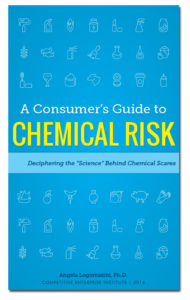When you see a headline or research paper that reports its findings “suggest” that a chemical is dangerous, be very wary of any claims that follow. “Suggestive” findings represent nothing much at all, yet researchers use the term all the time to generate interest in studies that yield findings too weak to really matter.
For example, in one study of the chemical Bisphenol A, researchers conclude: “Our study suggests that BPA could be a potential new environmental obesogen. Widespread exposure to BPA in the human population may also be contributing to the worldwide obesity epidemic.”(1) Their relative risk number was very low: 2.32. And this “finding” was only discovered within a subset of their sample: girls aged 9-12. The entire sample included 1,326 male and female school-age children (grades 4 to 12) living in Shanghai, China. The study measured the BPA levels in these children’s urine and correlated that with obesity levels.
It looks like they had to work the data to produce a subset with a positive relative risk and that the risk number is low enough to leave a good probability that is a mere statistical accident. The authors rationalize their claim by noting: “Other anthropometric measures of obesity showed similar results.”(2) And they note that that, although they could not find any association between BPA and obesity in boys, the “gender difference of BPA effect was consistent [emphasis added] with findings from experimental studies and previous epidemiological studies.”(3) But the mere existence of “other studies” with “similar” or “consistent” results does not make this study any more compelling.
There are many additional reasons to doubt this study, such as the fact that there is considerable evidence that the human body passes BPA quickly in urine before it can have any effects.(4) And there are plenty of studies that contradict this one. For example, another study found a link between BPA and obesity in non-Hispanic white boys, but not girls or other boys, which is inconsistent with the finding among girls and not boys in the Shanghai study.(5) Those researchers also cherry-picked a subset of their data to find an association.(6)
Another example is a study by Tufts University researchers, featured in a USA Today video, produced to promote breast cancer awareness month.(7) The authors write:
Our findings suggest [emphasis added] that developmental exposure to environmentally relevant levels of BPA during gestation and lactation induces mammary gland neoplasms in the absence of any additional carcinogenic treatment. Thus, BPA may act as a complete mammary gland carcinogen.”(8)
Interestingly, they use the word “suggest” because they did not actually find anything. The authors originally included a bolder statement in the study in the advance publication version. These researchers were forced to revise their paper after Forbes journalist Trevor Butterworth pointed out that the data did not support those claims.(9) Butterworth documents(10) the changes to the report that downgrade the researchers to claims to nothing more than “suggestive” results. Yet, the report still made headlines despite the findings not being particularly compelling and despite the existence of other more robust studies on the topic.(11)
Using the term “suggestive” to exaggerate weak and largely meaningless findings, is just one of the terms employed by the anti-chemical alarmist trade.
Browse the terms on the sidebar of this webpage for more details and/or download a copy of A Consumer’s Guide to Chemical Risk: Deciphering the “Science” Behind Chemical Scares.
(1) De-Kun Li et al.,”Urine Bisphenol-A Level in Relation to Obesity and Overweight in School-Age Children,” PLOS ONE 8, no 6 (June 12, 2013): e65399.
(2) Ibid.
(3) Ibid.
(4) Justin G. Teeguarden, et al., “Twenty-Four Hour Human Urine and Serum Profiles of Bisphenol A During High-Dietary Exposure,” Toxicological Sciences 123, no.1 (2011): 48–57.
(5) R. Bhandari, J. Xiao, and A. Shanka, “Urinary Bisphenol A and Obesity in U.S. Children,” American Journal of Epidemiology 177 no. 11, (June 1, 2013): 1263-70.
(6) For more details see: Geoffrey Kabat, “How Abysmal Scientific Research Is Used To Scare America’s Parents,” Forbes (online), August 20,2013.
(7) “Concerns about BPA and Breast Cancer,” USA Today video, October 8, 3013.
(8) Nicole Acevedo, et al, “Perinatally Administered Bisphenol A as a Potential Mammary Gland Carcinogen in Rats,” Environmental Health Perspectives 121, no. 9 (September 2013): 1040-1046.
(9) Trevor Butterworth, “Taxpayer-Funded Journal Walks Back BPA Cancer Claim after Statistical Meltdown,” Forbes (online), September 26, 2013.
(10) Trevor Butterworth, “BPA And Breast Cancer: When Academics Spin Statistics,” Forbes (online), July 30, 2013.
(11) Trevor Butterworth, “USA Today Spins Breast Cancer Scare Out Of Retracted Study Claim As New EPA Study Dismisses Risk,” Forbes (online), October 9, 2013.



[…] the meaning of studies reporting weak statistical associations. Other such phraseology includes “suggests,” or “consistent with.” Yet these associations only measure whether two factors happened at […]